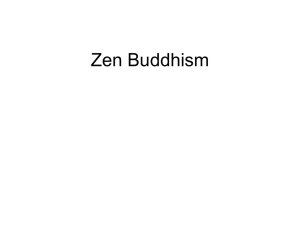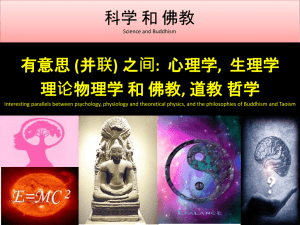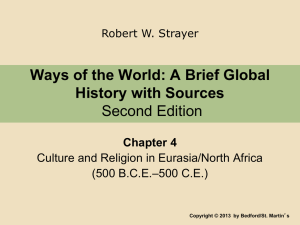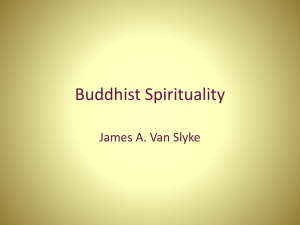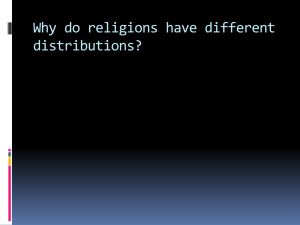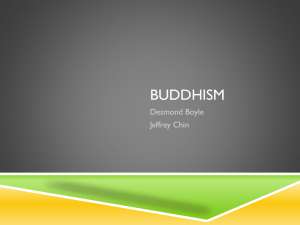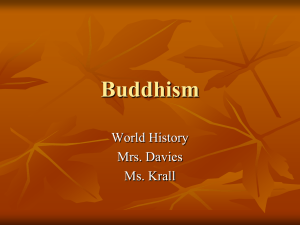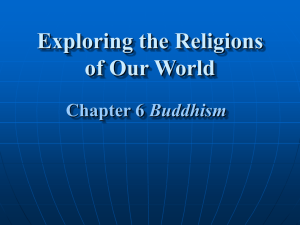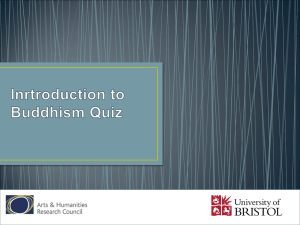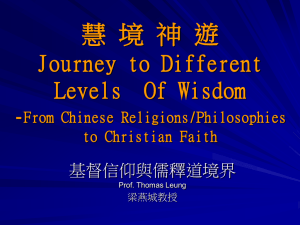Mahayana Buddhism
advertisement
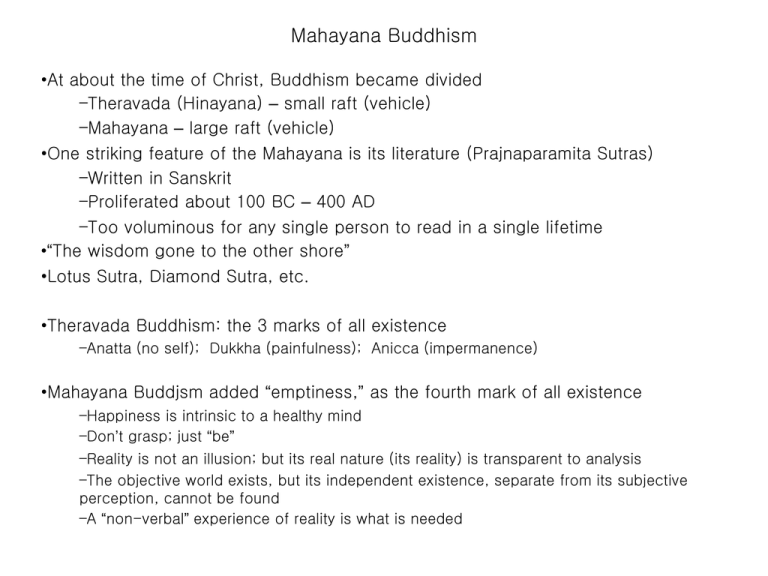
Mahayana Buddhism •At about the time of Christ, Buddhism became divided –Theravada (Hinayana) – small raft (vehicle) –Mahayana – large raft (vehicle) •One striking feature of the Mahayana is its literature (Prajnaparamita Sutras) –Written in Sanskrit –Proliferated about 100 BC – 400 AD –Too voluminous for any single person to read in a single lifetime •“The wisdom gone to the other shore” •Lotus Sutra, Diamond Sutra, etc. •Theravada Buddhism: the 3 marks of all existence –Anatta (no self); Dukkha (painfulness); Anicca (impermanence) •Mahayana Buddjsm added “emptiness,” as the fourth mark of all existence –Happiness is intrinsic to a healthy mind –Don’t grasp; just “be” –Reality is not an illusion; but its real nature (its reality) is transparent to analysis –The objective world exists, but its independent existence, separate from its subjective perception, cannot be found –A “non-verbal” experience of reality is what is needed • Different philosophies in the Mahayana school of Buddhism – Sthaviravadins – Pudgalavadins – Yogacarins – Madhyamika – Etc. • Subtle philosophical differences re: nature of ultimate reality and how we apprehend it • Varieties of Buddhism (diagram) • Comparison between the two schools (chart) Theravada (Hinayana) Mahayana – Teaching of the elders Spirit of the elders – Small vehicle Large (great) vehicle – Man as an individual Man involved with others – Man on his own in the universe Man is not alone (grace is real) – Key virtue: wisdom (bodhi) Key virtue: compassion (karuna) – Religion is primarily for monks Religion is for laypersons as well – Ideal: the Arhat (lonely saint) Ideal: the Bodhisattva – Nirvana Nirvana + heavens, hells – Buddha is a saint or sage Buddha is a savior – Avoids metaphysics (speculation) Elaborates metaphysics – Avoids ritual Includes ritual – Conservative Liberal – Pali texts Many later texts (Sanskrit) – Old wisdom school New wisdom school – Escape Samsara, and reach Nirvana Samsara is Nirvana (identity) – Ceylon, Burma, etc. (Southern Bism) China, Korea, Japan (N Bism) • Most Mahayanists hold that Buddha privately taught that man does not have to save himself; there is help available. The number of Buddhas proliferated. The authors of salvation are of three kinds: – Manushi Buddhas (started from a human base – Gotama Buddha) • They came on earth, attained enlightenment, and are now gone. They are teachers • Gotama before his enlightenment – Bodhisattvas • Beings who vowed to become Buddhas and have enormous merit; they postponed their entrance to Nirvana to help us • Maitreya, Avalokitesvara, Kwan Yin, Amitabha – Dhyani Buddhas (meditation Buddhas, never in human form) • They achieved Buddha-hood, but not in human manifestation • Vairocana, Amitabha are the most appealing of the D. Buddhas • • Also, a mythology about the Buddha developed (Buddhology) The Trikaya (Triple Body of the Buddha) – Dharmakaya (analogous to the “Godhead”) – Sambogakhaya (analogous to the “resurrected” Christ) – Nirmanakaya (analogous to the historical Jesus of Nazareth) The Bodhisattva became popular • A being whose essence is enlightenment • The bodhisattva vow (to save all sentient beings) [Vision p 41] • Daily schedule of the schools of Buddhism (Theravada, Zen, Tibetan) – Rise at 4 am – Lunch is the main meal – To bed by 10 pm – A lot of time given to study/work • Re: the conduct of the various schools – Symbiotic relationship – Conduct (gives merit, or punya) includes • Rules of restraint (5 and 5) • The perfections towards which we should strive • Taking responsibility for one’s actions • • • • The main objective in Buddhism is to attain liberation Buddhism has fragmented: there are many different schools In Japan alone, there are over 180 differentiated schools of Buddhism Several important schools, all of which have the same ultimate objective – Pure Land Buddhism (getting to heaven, or the “pure land”) – Ch’an, Zen, Son (meditative Buddhism) – Tendai (Rationalist School) – Nichiren (Sociological and political) – Tibetan (esoteric) – Let us look at each of these in turn….. • Pure Land Buddhism – Faith in Amidha Buddha and recitation and meditation on his name – Religious goal of being reborn in his Pure Land and meditation on his name – This present age is an age of decay • (pure dharma, compromised dharma; Mappo: latter day dharma) – In Japan often called Amidhism • In 12 century the monk Honen became persuaded that in our corrupt age the only successful road to enlightenment is through a complete dependence on Amidha – The mythological side of the movement centered on the Buddha of boundless light, Amitabha, although Kuan Yin over overshadowed Amida – The Pure Land of the West exists infinitely far away as the Western edge of the universe (or it can be realized here and now in one’s present life) – Jodoshu (Pure Land Buddhism) was founded by Honen (1133-1212) – He did 60,000 bows in one day (?) – Reciting the nembutsu (namu amida butsu) is the only way to “endure” or “make it” in the last days – Repeating the formula can bring salvation – Salvation is impossible by meditation or asceticism – Jodoshinshu (True PLBuddism) was founded by Shinran (1173-1263) – Salvation by grace alone – “If salvation is by faith, the monastic rule avails a man nothing” – Parallel with Martin Luther in the course of faith re: monasticism – The Pure Land Sutra – Culmination of Pure Land Buddhism – Nembutsu, but with faith (tariki: other power school) – He shifted the attention from practice, to attitude – He made the act of faith itself the essential basis of salvation – The act of faith was made not by the person, but by the Buddha acting in that person (similar to Karl Barth-W. theologian) • • • • • • • • • • Ch’an (China), Zen (Japan), Son (Korea) Zen Buddhism is very popular in the West Buddha’s “flower sermon” (the disciple Ananda) 28 patriarchs 1. Sakyamuni…..28. Boddhidharma 1) “A special oral transmission from master to disciple outside of scripture 2) No dependence upon the authority of words and letters (anti-intellectual) 3) Direct pointing to the soul of man 4) Seeing into one’s own nature and attaining Buddha-hood The 10 Ox-Herding pictures • • Rinzai school (Eisai): sudden enlightenment with a “Koan” (ie Wonhyo in Korea) – Short pithy utterance (sound of one hand clapping?) – Designed to disrupt the normal, everyday mental machinery – “Great death” leads to satori (enlightenment)** (see notes) Soto school (Dogen): gradual enlightenment (without a koan) • • • Very popular in the Western world The western scholar and the Zen master with a filled cup of tea Zen and the Art of Archery • Rationalist school of Tendai (Tien Tai) – An eclectic school – One of China’s great schools of Buddhism – Tries to reconcile Theravada and Mahayana (inclusive point of view) – Meditation should be balanced by a prolonged and serious study of texts – Has a place for all the Buddhist scriptures – Most popular and important text is the Lotus Sutra • Locus classicus is the “burning home” passage (Vision p 218) – Also contains a “parable of the prodigal son,” rather similar to the Bible • Lotus Sutra (Saddharma) – Contains the essence of all the teachings of the Buddha – Doctrine that the Buddha taught differently at the different stages of his life – He taught according to the understanding of his hearers (like Jesus) – Upaya (skillful means) • Originally the doctrines of the Theravada sutras • Later, in progressively profounder versions, the Mahayana doctrines • The fullest revelation of eternal truth is in the Lotus Sutra • All men can become the Buddha, because all possess the Ba nature • Various teachings are necessary to meet various needs • Tendai scholars made use of the doctrine of the 3 bodies of the Ba • The Ba as absolute truth manifests in the realm of phenomena both as historical teacher and as celestial object of worship and adoration • Scholars arranged various writings in a hierarchy • At the summit was the Lotus Sutra • Nichiren (a socio-political school of Mahayana Buddhism) – Soka Gakkai; Risho Kosekai – Has become very political – Seemingly has lost the spirit of Buddhism • Tibetan Buddhism and the Tibetan School – The reasoned knowledge of the schools, distilled into books, is not as effective in awakening one to enlightenment as live experience under a guru able to conduct magically potent secret exercises which can bring one into direct contact with ultimate reality – Tantrayana – Mandalas – Bardo Thodol • (Bardo: intermediate state; Thodol: great liberation by “hearing”) • The “Tibetan Book of the Dead” • Deals with transition states • Between death and passing; between jobs; between moments of security (ie at moments of insecurity and uncertainty) • We are confronted by our demons; how we handle them determines our destiny • • New Religious Movements (especially in Japan) Tenchi Seikyo – Maitreya Buddha – Beautiful white marble statue – Doctrines similar to UM • Won Buddhism – Indigenous to Korea – One circle (see chart) • Buddhist art – Very significant and beautiful – Not just for decoration, but are visual images of the Buddha at various points along his life path • • Buddhist influence on the early desert fathers of Christianity “Two Messages, One Doctrine”

